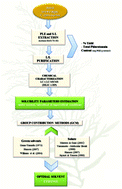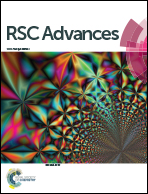Application of Hansen solubility approach for the subcritical and supercritical selective extraction of phlorotannins from Cystoseira abies-marina†
Abstract
Cystoseira abies-marina is one of the most important brown algae species found in the Mediterranean Sea and Atlantic Ocean ecosystems and has been reported as a promising source of phenolic compounds, including phlorotannins, with important biological activities. In the present work, the possibility of developing new green processes to eliminate/replace the use of traditional polluting and often toxic solvents to obtain phlorotannin-enriched extracts is explored, looking for higher efficiency and compliance with the rules of green chemistry. The theoretical modelling of the Hansen solubility parameters could provide a useful and accurate estimation for the solvent selection and prediction of the solubility of these natural bioactive compounds. In order to drive the process towards the extraction of the target compounds, the chemical composition of phlorotannins from Cystoseira abies-marina was determined using a comprehensive two-dimensional liquid chromatography (LC × LC-MS/MS) method. Phlorethols, fucols or fucophlorethols containing from 3 to 14 phloroglucinol units (PGU) were tentatively identified. The estimation of Hansen solubility parameters of the most abundant phlorotannins (7 PGU) in some green solvents (ethanol, water, ethyl lactate and CO2 + ethanol) under sub- and supercritical conditions was carried out to improve their selective extraction and is presented for the first time. According to the theoretical approach, low temperatures of the extraction solvents provide the minimum Ra (difference in solubility parameter). However, this work experimentally demonstrates that pure ethanol at 100 °C showed the highest selectivity to extract phlorotannins. The Hansen approach proves to be a profitable tool to select a suitable solvent for extraction purposes.


 Please wait while we load your content...
Please wait while we load your content...